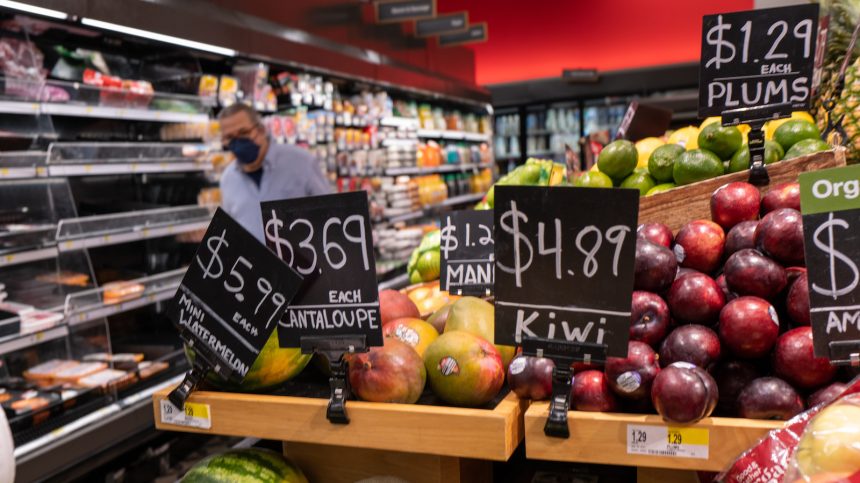It’s no secret that a warming world will drive food prices higher, a phenomenon increasingly known as “heatflation.” What’s less known, but a growing area of interest among economists and scientists alike, is the role individual extreme weather events – blistering temperatures in Texas, a destructive tornado in Iowa – may have on what U.S. consumers pay at the supermarket.
At first glance, the answer might seem logical: A drought or flood that impacts agricultural production will, eventually, drive up prices. But it’s not that simple, because what consumers pay for groceries isn’t only reflective of crop yields or herd sizes, but the whole supply chain. That’s where it gets interesting: Economists are beginning to see a growing trend that suggests weather forecasts play a part in sticker shock. Sometimes the mere prediction of an extreme event – like the record-breaking temperatures, hurricanes, and wildfires forecasters are bracing for this summer – can prompt a spike in prices.
“It isn’t the forecast itself to blame, but concerns about what the weather to come might mean for the entire supply chain, as food manufacturers manage their risks and the expected future value of their goods,” said Seungki Lee, an agricultural economist at Ohio State University. “When it comes to the climate risk on food prices, people typically look at the production side. But over the last two years, we learned that extreme weather can raise food prices, [cause] transportation disruptions, as well as production disruptions.”
Supply chain disruptions and labor shortages are among the reasons food prices have climbed 25 percent since 2020. Climate change may be contributing as well. A study published earlier this year found “heatflation” could push them up by as much as 3 percentage points per year worldwide in just over a decade and by about 2 percentage points in North America. Simultaneous disasters in major crop and cattle producing regions around the world – known as multi-breadbasket failure – are among the primary forces driving these costs.
Historically, a single, localized heat wave or storm typically wouldn’t disrupt the supply chain enough to prompt price hikes. But a warming world might be changing that dynamic as extreme weather events intensify and simultaneous occurrences of them become the norm. How much this adds to consumers’ grocery bills will vary, and depends upon whether these climate-fueled disasters hit what Lee calls “supply chain chokepoints” like vital shipping channels during harvest seasons.
An ongoing drought that plagued the Mississippi River system from the fall of 2022 until February provides an excellent example of this. The Mississippi River basin, which covers 31 states, is a linchpin of America’s agricultural supply chain. It produces 92 percent of the nation’s agricultural exports, 78 percent of the world’s feed grains and soybeans, and most of the country’s livestock. Vessels navigating its roughly 2,350 miles of channels carry 589 million tons of cargo annually.
Transportation barriers created by low water hampered the ability of crop-producing states in the Corn Belt to send commodities like corn and soybeans, primarily used for cattle feed, to livestock producers in the South. Thus emerged a high demand, low supply situation as shipping and commodity prices shot up, with economists expecting consumers to absorb those costs.
This capricious consumer cost effect is due largely to the resiliency of America’s food system. Public safety nets like crop insurance and other federal programs have played a large part in mitigating the impacts of adverse weather and bolstering the food supply chain against climate change and other shocks. By ensuring farmers and producers don’t bear the brunt of those losses, these programs reduce the costs passed on to consumers. Advanced agricultural technology, modern infrastructure, substantial storage, and efficient transport links also help ensure retail price stability.
Last year was the world’s warmest on record, creating an onslaught of challenges for crop and livestock producers nationwide. And this year is primed to be even more brutal, with the transition from El Niño – an atmospheric phenomenon that warms ocean temperatures – to La Niña, its counterpart that cools them. This cyclical change in global weather patterns is another potential threat for crop yields and source of supply chain pressures that economists and scientists are keeping an eye on.
They will be particularly focused on the Midwest and stretches of the Corn Belt, two regions prone to drought as an El Niño cycle gives way to a La Niña, according to Weston Anderson, an assistant research scientist at the University of Maryland and NASA Goddard Space Flight Center. Those growing regions for corn and soybeans are what he’ll be watching closely as La Niña develops.






